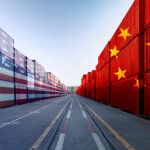
Here’s what three years of US sanctions did to Huawei. (Photo by JESSICA YANG / AFP)
What three years of US sanctions did to Huawei
- Since the US sanctions, Huawei has replaced more than 13,000 components in its range of products with local substitutes and redesigned over 4,000 circuit boards.
- Huawei spent US$23.8 billion on research and development alone in 2022.
- Huawei’s founder clarified that the company would not enter the ChatGPT space.
- The company will also launch MetaERP, its resources planning system, and fully use its operating system, data system, compiler, and language.
Huawei Technologies Co may be the crown jewel of China’s tech industry, but for the US, the company’s espionage, ties to the state, and 5G wireless equipment have posed and still pose a security risk. Whether Huawei was, in fact, spying and misusing data is a separate matter because, for the West, the rise of Chinese companies is linked to the Chinese government’s power and its brand of techno-authoritarianism.
Huawei paid a hefty price for years, considering successive administrations in the US have regarded the Chinese giant as a national-security risk, claiming that it has deep links with the People’s Liberation Army and that its gear could be used for spying. All those allegations have neither been proven by the US nor accepted by Huawei.
Soon enough, the American government banned Huawei’s wares at home and urged allies to ditch them from their 5g mobile networks. It was followed by countless trade restrictions, which eventually hampered Huawei’s position as one of the fastest-growing mobile phone providers not just in China but in most parts of the world.
By April 2022, Huawei’s rotating chairman Eric Xu Zhijun, amid threats of fresh US sanctions, shared that the company is bleeding at least US$30 billion in annual losses to its smartphone business. The upside is that, according to Xu, the company is already accustomed to working and living with the US Entity List by then.
Fast forward to last week, the company’s founder, Ren Zhengfei, for the first time, shared additional insights on the company’s progress in overcoming years of US sanctions. Ren shared that in the past three years, Huawei has replaced more than 13,000 components in its range of products with local substitutes and redesigned over 4,000 circuit boards.
He delivered a speech during a seminar on February 24 at Nanjing University, to thank the public and academics who participated in the company’s search for solutions to its technology predicament. According to a transcript of his speech published by Nanjing University on Friday, Ren said production of circuit boards has “stabilized” after the Chinese telecoms giant developed replacement parts from domestic sources.
He also shared that Huawei had spent US$23.8 billion on research and development in 2022. “After the US sanctions impacted its smartphone business, the company began looking for more opportunities in enterprise solutions, such as helping traditional industries to digitalize their operations,” the South China Morning Post article reads.
For context, Huawei, the world’s largest provider of telecommunications equipment, has been devoting more of its revenue to research for the development of new technologies as a way to derail US trade and investment sanctions. In 2021, the tech giant’s R&D budget was US$22.1 billion — more than any company outside America.
Ren also shared that ChatGPT “is not something we will work on,” according to the transcript. But he reckons Microsoft’s OpenAI will not be the only dominant player in the field. The opportunity generated by ChatGPT means the industry will need more computing power, which will create more demand for Huawei’s products, he added.
READ MORE
- Ethical AI: The renewed importance of safeguarding data and customer privacy in Generative AI applications
- How Japan balances AI-driven opportunities with cybersecurity needs
- Deploying SASE: Benchmarking your approach
- Insurance everywhere all at once: the digital transformation of the APAC insurance industry
- Google parent Alphabet eyes HubSpot: A potential acquisition shaping the future of CRM


